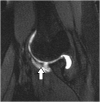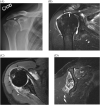Imaging of traumatic shoulder injuries - Understanding the surgeon's perspective
- PMID: 35265737
- PMCID: PMC8899241
- DOI: 10.1016/j.ejro.2022.100411
Imaging of traumatic shoulder injuries - Understanding the surgeon's perspective
Abstract
Imaging plays a key role in the assessment and management of traumatic shoulder injuries, and it is important to understand how the imaging details help guide orthopedic surgeons in determining the role for surgical treatment. Imaging is also crucial in preoperative planning, the longitudinal assessment after surgery and the identification of complications after treatment. This review discusses the mechanisms of injury, key imaging findings, therapeutic options and associated complications for the most common shoulder injuries, tailored to the orthopedic surgeon's perspective.
Keywords: ABER, abducted and external rotated; AC, acromioclavicular; AHI, acromiohumeral interval; ALPSA, anterior labral periosteal sleeve avulsion; AO, Arbeitsgemeinschaft für Osteosynthesefragen; AP, anteroposterior; Acromioclavicular (AC) joint separation; CT, computed tomography scan; Clavicle facture; GLAD, glenolabral articular disruption; Glenohumeral dislocation; MR, magnetic resonance; MRI, magnetic resonance imaging; ORIF, open reduction and internal fixation; Proximal humerus fracture; RCT, rotator cuff tear; Scapular fracture; Traumatic rotator cuff tear; US, ultrasound scan.
© 2022 The Authors. Published by Elsevier Ltd.
Conflict of interest statement
The authors declare that they have no known competing financial interests or personal relationships that could have appeared to influence the work reported in this paper.
Figures
































Similar articles
-
Anterior Shoulder Instability Management: Indications, Techniques, and Outcomes.Arthroscopy. 2020 Nov;36(11):2791-2793. doi: 10.1016/j.arthro.2020.09.024. Arthroscopy. 2020. PMID: 33172578
-
Fracture of the scapular neck combined with rotator cuff tear: A case report.World J Clin Cases. 2020 Dec 26;8(24):6450-6455. doi: 10.12998/wjcc.v8.i24.6450. World J Clin Cases. 2020. PMID: 33392330 Free PMC article.
-
In vivo dynamic acromiohumeral distance in shoulders with rotator cuff tears.Clin Biomech (Bristol). 2018 Dec;60:95-99. doi: 10.1016/j.clinbiomech.2018.07.017. Epub 2018 Jul 26. Clin Biomech (Bristol). 2018. PMID: 30340151
-
Advanced imaging of glenohumeral instability: the role of MRI and MDCT in providing what clinicians need to know.Emerg Radiol. 2017 Feb;24(1):95-103. doi: 10.1007/s10140-016-1429-7. Epub 2016 Aug 13. Emerg Radiol. 2017. PMID: 27519693 Review.
-
Does Distal Clavicle Resection Decrease Pain or Improve Shoulder Function in Patients With Acromioclavicular Joint Arthritis and Rotator Cuff Tears? A Meta-analysis.Clin Orthop Relat Res. 2018 Dec;476(12):2402-2414. doi: 10.1097/CORR.0000000000000424. Clin Orthop Relat Res. 2018. PMID: 30334833 Free PMC article.
Cited by
-
High-Resolution Imaging Insights into Shoulder Joint Pain: A Comprehensive Review of Ultrasound and Magnetic Resonance Imaging (MRI).Cureus. 2023 Nov 17;15(11):e48974. doi: 10.7759/cureus.48974. eCollection 2023 Nov. Cureus. 2023. PMID: 38111406 Free PMC article. Review.
-
Screw Stress Distribution in a Clavicle Fracture with Plate Fixation: A Finite Element Analysis.Bioengineering (Basel). 2023 Dec 7;10(12):1402. doi: 10.3390/bioengineering10121402. Bioengineering (Basel). 2023. PMID: 38135993 Free PMC article.
-
Advances in the Non-Operative Management of Multidirectional Instability of the Glenohumeral Joint.J Clin Med. 2022 Aug 31;11(17):5140. doi: 10.3390/jcm11175140. J Clin Med. 2022. PMID: 36079068 Free PMC article.
-
Posterior Shoulder Instability in Tennis Players: Aetiology, Classification, Assessment and Management.Int J Sports Phys Ther. 2023 Jun 1;V18(3):769-788. doi: 10.26603/001c.75371. eCollection 2023. Int J Sports Phys Ther. 2023. PMID: 37425109 Free PMC article.
References
-
- Quillen D.M., Wuchner M., Hatch R.L. Acute shoulder injuries. Am. Fam. Phys. 2004;70:1947–1954. - PubMed
-
- Sheehan S.E., Gaviola G., Gordon R., Sacks A., Shi L.L., Smith S.E. Traumatic shoulder injuries: a force mechanism analysis-glenohumeral dislocation and instability. AJR Am. J. Roentgenol. 2013;201:378–393. - PubMed
-
- Neer C.S., 2nd Displaced proximal humeral fractures. I. Classification and evaluation. J. Bone Jt. Surg. Am. 1970;52:1077–1089. - PubMed
Publication types
LinkOut - more resources
Full Text Sources

